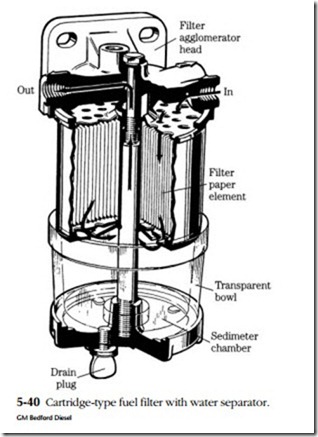Fuel filters and water separators
Most engines incorporate three stages of filtration—a screen at the tank and paper-element primary and secondary filters. Filters are rated by the size of particle trapped: a typical installation would employ a 30-micron primary filter and a secondary
of between 10 and 2 microns. A water separator is often built into the primary filter (Fig. 5-40), which also may include a connection for fuel return and an electric heater to prevent fuel gelling and waxing in cold climates.
When a filter element is changed, entrapped air must be bled as described in Chapter 4.
Related posts:
Electricity and potentially explosive atmospheres:Inspection and maintenance
Grounding Tower Elements:Facility Ground Interconnection.
Taxonomy of Uncertainty Modeling Techniques in Renewable Energy System Studies:Probabilistic Approac...
COAL-FIRED POWER PLANTS:TRADITIONAL COAL-FIRED POWER GENERATION TECHNOLOGY
COAL-FIRED POWER PLANTS:BOILER TECHNOLOGY
Testing and Commissioning of Protective Relays and Instrument Transformers:Event Reporting
BIOMASS-BASED POWER GENERATION:FUELWOOD AND ENERGY CROPS
The Current Situation and Perspectives on the Use of Nuclear Energy for Electricity Generation:Switz...
Motors and Generators:DC Motors and Generators and Repulsion-Induction Motors
The Current Situation and Perspectives on the Use of Wind Energy for Electricity Generation:Belgium
COAL-FIRED POWER PLANTS:COAL CLEANING AND PROCESSING
Drive power circuits.
Fundamentals of Distribution Systems
Rudolf Diesel
FUEL CELLS:FUEL CELL EFFICIENCY
